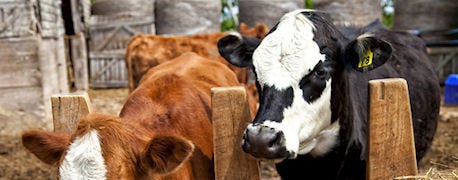
The nation's 89.297 million head Jan. 1 cattle herd is the smallest since 1952's 88.072 million. That's one conclusion from data USDA's National Agricultural Statistics Service gathered on inventory numbers from beef and dairy cattle owners who responded to surveys for USDA's annual Cattle Report released Friday.
Sixty years ago herd rebuilding surged the inventory 6.169 million head larger by Jan. 1, 1953. No such inventory rebuilding will occur over the next 11 months. Threats of continuing drought all but assure no expansion will occur this year. The Jan. 1, 2014 total U.S. beef and dairy herds may well be smaller than this year's Jan. 1 figure.

Beef cow and beef replacement heifer figures suggest producers are working to get a younger breeding herd. Feeder cattle supply down 1.5% will keep them pricy.
The 89.297 million head all cattle and calf inventory came in at 98.4% of the year-earlier value, vs. the average trade guess of 98.2%. The difference between the average trade guess and USDA's actual survey number amounts to about 170,000 cattle spread over all categories. For perspective Friday's cattle slaughter totaled 122,000 head. So we're talking a day and half of production.
The inventory coming in a bit larger than expected could be construed as bearish. After an initial reaction Monday morning, traders will likely refocus on beef demand, grazing conditions and expected feed costs going forward.
The beef cow inventory, at 97.2% of a year ago, came in smaller than the average trade guess of 98.5%. However, beef heifers kept for replacements came in at 101.2% of a year ago, vs. the average trade guess of 99.6%. Those figures suggest cow-calf producers chose to ship more aging cows to slaughter and maintain the herd with younger females.
Feeder cattle to remain scarce
Two straight years of drought have forced producers to trim herds. Lack of grazing, scarce harvested forages and pricy supplemental feeds have disrupted feedlot placement patterns. The last two years, cattle have generally moved from cow-calf producers to feedlots earlier than normal. That shift in placements reflects both overall tightening of supplies and huge concerns about feeder cattle supplies going forward.

One measure of feeder cattle supplies outside of lots is to combine the Jan. 1 inventories of:
-Calves under 500 pounds
-Steers over 500 pounds
-Heifers over 500 pounds not kept for cow herd replacement
Friday's report pegs that total at 38.817 million head, down 1.5% from the Jan. 1, 2012 value for that measure of 39.401 million head. While the Jan. 1 supply of cattle outside of feedlots has not declined steadily, the Jan. 1 2013 figure was well below the Jan. 1, 2000 figure of 43.645 million cattle.
Feeder cattle supplies will remain tight—and pricy—well into 2014, likely beyond. Feeder cattle prices will hinge heavily on how 2013 the grazing season and crop prospects shape up.
About the Author(s)
You May Also Like




